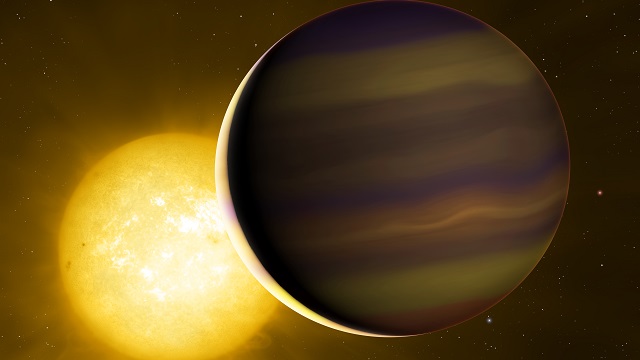Chemical fingerprint of the exoplanet Osiris shows unexpectedly high carbon.
Find out how astronomers have used spectroscopy to analyse the chemical composition of the atmosphere of Osiris. This resource is best suited to Chemistry, Earth and Space and Physics students in Years 8, 9, 10, 11 and 12.
Word Count: 466

An international team of astronomers has uncovered the atmospheric composition of the exoplanet HD 209458b (AKA Osiris), giving clues about its birthplace.
In a study published in Nature, the team used the Telescopio Nazionale Galileo in La Palma, Spain, to capture the light from the exoplanet’s parent star as it shot through Osiris’s atmosphere. By analysing the spectrum, they found six different chemicals including hydrogen cyanide, methane, ammonia, acetylene, carbon monoxide and low amounts of water vapour.
This is the first time that so many different molecules have been measured in the exoplanet’s atmosphere, and it shows that the planet has double the amount of carbon than expected.
“The key chemicals are carbon-bearing and nitrogen-bearing species,” says co-author Siddharth Gandhi of the University of Warwick in the UK. “If these species are at the level we’ve detected them, this is indicative of an atmosphere that is enriched in carbon compared to oxygen.
“We’ve used these six chemical species for the first time to narrow down where in its protoplanetary disc it would have originally formed.”
Fast Facts: Exoplanet Osiris
- The exoplanet HD 209458b (nicknamed Osiris) is located in the constellation of Pegasus, around 159 light-years from Earth.
- It was the first to be discovered via the transit method, where astronomers detect a tiny dip in the light of a star when a planet travels in front of it.
- HD 209458b is a gas giant about two-thirds the mass of Jupiter, but it orbits blisteringly close to its star – an eighth of the distance between Mercury and our Sun.
- Temperatures on its surface are estimated to reach 1000°C.
- It was the first exoplanet confirmed to have an atmosphere, and the first exoplanet atmosphere known to contain carbon and oxygen.
A carbon-rich atmosphere suggests that the planet preferentially gathered up gas rich in carbon as it formed. This means it must have been born much further out in its solar system than its current position, a mere seven million kilometres from its star.
“There is no way that a planet would form with an atmosphere so rich in carbon if it is within the condensation line of water vapour,” Gandhi explains.
Models of planetary formation suggest that as a solar system forms, hotter planets close to a star gain a large proportion of oxygen in the atmosphere in water vapour. But further out, the water vapour condenses and becomes locked up in the planet’s core, leaving more carbon- and nitrogen-based molecules in the atmosphere.
This means Osiris must have formed far away from its star before migrating into its current position.
Co-author Matteo Brogi, also from the University of Warwick, says: “By scaling up these observations, we’ll be able to tell what classes of planet we have out there in terms of their formation location and early evolution.”
This article is republished from Cosmos. Read the original article.
Login or Sign up for FREE to download a copy of the full teacher resource





